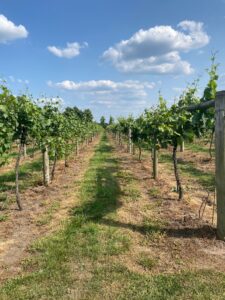•
(Caution: Contains spoilers for Episode: S17E04: A Vintage Murder)
Diesen Beitrag gibt es auch auf Deutsch.
•
Elspeth Rice has just returned from measuring the depth of a lake in Midsomer Vinae. She is deeply concerned about the results, as this lake holds a painful memory for her. Five years ago, she accidentally hit and fatally injured young Jessica Tyler, and her car sank into this very lake. Nothing should incriminate her. Elspeth has been struggling to forgive herself ever since, and in an effort to protect herself, she made some regrettable choices.
At the trial, she confidently testified that she saw Nadia Simons’s black car at the scene of the accident, driving at dangerously high speeds and probably under the influence of alcohol. This occurred after the launch of Carnarvon’s first Midsomer Vinae wine, to which Simons was invited. Elspeth was unkindly intruding on her friend and Jessica’s mother, Judy Tyler, and telling her that Jessica’s death was caused by Nadia Simons, who is known for her drunk-driving. The Carnarvons had invited her to their wine presentation, possibly to distract from her.
“It’s England. It always rains.”

Here’s how the animosity between the Tylers and the Carnarvons, who run the vineyard, originated. The latter are unaware of the situation, and the Tylers are outraged that the Carnarvons, despite being perceived as guilty, have shown themselves to be innocent.
In recent years, Elspeth Rice’s web of lies has taken on a life of its own and become more complex. Elspeth Rice confidently stirs the pot, ensuring that what lies beneath the surface – or rather, in the lake – remains hidden.
She cycles to the vineyard in a hurry, where she meets Kevin Payton, a young man who works at the vineyard and would like to take it over later. Of course, Kevin doesn’t understand why Elspeth is so upset that the lake level has dropped a few centimetres. It rains so often in England that the level will rise again.
While they are discussing, DCI John Barnaby arrives and watches them, then walks straight up to them.
Big vineyards in Great Britain? Absolutely.
By the way, did you know that the village is named Midsomer Vinae because the Romans produced wine in this area?

The Romans, who conquered the British Isles in 43 AD, were known for their knowledge of viticulture. In fact, Historiae Augustae Probus, 18.8, dating from 270 AD, confirms that the Gauls, Spaniards, and Britons were all granted permission to cultivate vineyards and make wines.
While it is true that viticulture did not exist in Britain in the first decades, it is all too logical that the Romans brought their wine culture with them and made it part of British life. While Tacitus wrote in 100 AD that olives and wine were not present in Britain, it is likely that both occurred in the 3rd century.
It may come as a surprise, but at the time of the Romans, the climate in Britain was actually a little warmer than it is today, with an average annual rainfall of 500-600 mm (compared to today’s 800-1,400 mm). This also explains the Roman origins of the 46 vineyards mentioned in the Domesday Book in Suffolk, which played a role in the development of the wine industry in the UK. In fact, a vineyard there covering an area of 11 hectares (about 20 football pitches) has even been discovered. In some counties, such as Buckinghamshire, few vineyards have been documented or found. The county currently has only one documented vineyard.
But is it really the case that wine was grown in Midsomer Vinae in Roman times?

The answer is as short as it is disappointing: No. the vinery Stanlake Park in Berkshire, which served as the location for the Midsomer Vinae vineyard, was not established until 1979. But: It has been a place for vineyards for a very long time, although not from Roman times, but from Norman times. Grapes have been growing here since the 12th century.
The manor of William Carnarvon, however, stands on the site of a wooden building from the Middle Ages. There is no evidence of Roman origins, but the recent building is a 16th century manor, built by the Aldworth family before moving to Billingbear House. A royalist family who fought for Charles I in the British Civil War. It was later rebuilt in the brick style of today.
Fortunately, there are a few Roman sites in Berkshire that we know by name, with most of them being located to the west of Stanlake Park and approximately 25 miles (72 km) away. Additionally, the important manufacturing location of Wickham Bushes at Easthampstead is only 7 miles (11 km) to the south of Stanlake Park.
The Roman Civitas Atrebates was mainly comprised of what is now Berkshire county, with a council located at Calleva Atrebatum/Silchester (now in Hampshire). It is worth noting that Calleva Atrebatum was well-connected. Civitas Atrebates was a hub of activity, with roads leading to Dorchester-on-Thames, St Albans (known as ‘Camlet Way’), London (known as the Devil’s Highway) and Cirencester (known as ‘Ermin(e) Way’).
The community offered a variety of trades, including farming, pottery, shoemaking, dyeing, woodworking, stonemasonry, and blacksmithing. While wine was traded in Civitas Atrebates, it was not cultivated there.
Read more about Midsomer Murders & History
The Chronology of Midsomer County by Year or by Episodes
Deep Dives into Midsomer & History
This is an independent, non-commercial project. I am not connected to Bentley Productions, ITV or the actors.

Further readings: How long does it take from Rome to Britain?
- “ORBIS. The Stanford Geospatial Network Model of the Roman World” – Stanford University’s Walter Scheidel and Elijah Meeks have confidently developed an online tool for planning routes in Roman times. We hope you find this information helpful and friendly. It’s worth noting that Verulamium, the Roman settlement, was located in St Albans.
- Main Roman roads and towns of Berkshire.
- And another maps of Roman routes in Britain.
Literature
- “Beach Combing”: Roman and Medieval Vineyards in Chilly Britain. In: Beachcombing’s Bizarre History Blog. (24/12/2012).
- Brown, Tony et al.: Roman Vineyards in Britain. Stratigraphic and palynological data from Wollaston in the Nene Valley, England. In: Antiquity 75 (2015). P. 745-757.
- Frere, Sheppard: Verulamium Excavations. Band III. Oxford 1983. P. 26-28.
- Fryer Ward, Samantha: In Vino Veritas. The Roman roots of our English wine industry. In: Corinium Museum. (17/06/2022).
- Greenaway, Jill: Solent-Thames Research Framework Roman Berkshire. In: Oxford Archaeology (November 2006).
- Keys, David: Veni, vidi, viticulture – remains of Roman vineyards found in UK. In: Independent (16/11/1999).
- Nash Ford, David: Moated Manors. In: Royal Berkshire History.
- Nash Ford, David: Berkshire History, Roman Times. In: Royal Berkshire History.
- Wacher, John: The Towns of Roman Britain. London/New York 21997. p. 214-217.
- Williams, D.: A Consideration of the Sub-Fossil Remains of Vitis vinifera L. as Evidence for Viticulture in Roman Britain. In: Britannia 8 (1977). P. 327-334.
First published on MidsomerMurdersHistory.org on 26 January 2024.
Updated on 25 July 2025.


9 thoughts on “Roman Vineyards”